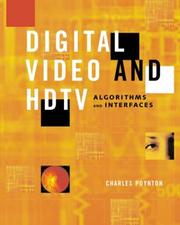| Listing 1 - 6 of 6 |
Sort by
|

ISBN: 0830632727 083069272X 9780830632725 Year: 1990 Publisher: Blue Ridge Summit, PA : TAB Books,
Abstract | Keywords | Export | Availability | Bookmark
 Loading...
Loading...Choose an application
- Reference Manager
- EndNote
- RefWorks (Direct export to RefWorks)
High definition television. --- HDTV --- Televisietechniek --- High definition television --- HDTV (Television) --- Television

ISBN: 0521826241 0521033551 0511073690 051117053X 0511073674 0511326610 0511490941 1280431180 1139149091 0511073682 9780511073694 9780511073687 9780511490941 9780521826242 9780521033558 Year: 2004 Publisher: Cambridge Cambridge University press
Abstract | Keywords | Export | Availability | Bookmark
 Loading...
Loading...Choose an application
- Reference Manager
- EndNote
- RefWorks (Direct export to RefWorks)
In the late 1980s and 1990s, the advanced industrial countries considered replacing the existing analogue television infrastructure with a new digital one. A key common feature to the debates over digital TV (DTV) in the United States, Western Europe and Japan was the eventual victory of the ideas of digitalism (the superiority of everything digital over everything analogue) and of digital convergence (the merging of computing, telecommunications and broadcasting infrastructures made possible by digitalization) in public debates over standards. Jeffrey Hart's book shows how nationalism and regionalism combined with digitalism to produce three different and incompatible DTV standards in the three regions, an outcome which has led to missed opportunities in developing the new technologies. Hart's book contributes to our understanding of relations between business and government, and of competition between the world's great economic powers.
Social Sciences --- Political Science --- Competition, International --- High definition television --- HDTV (Television) --- International competition --- World economics --- Government policy --- Competition, International. --- International relations --- International trade --- War --- Television --- Economic aspects

ISBN: 9781558607927 9780080504308 0080504302 1558607927 0585457956 9780585457956 Year: 2003 Publisher: Amsterdam Boston Morgan Kaufmann Publishers
Abstract | Keywords | Export | Availability | Bookmark
 Loading...
Loading...Choose an application
- Reference Manager
- EndNote
- RefWorks (Direct export to RefWorks)
Rapidly evolving computer and communications technologies have achieved data transmission rates and data storage capacities high enough for digital video. But video involves much more than just pushing bits! Achieving the best possible image quality, accurate color, and smooth motion requires understanding many aspects of image acquisition, coding, processing, and display that are outside the usual realm of computer graphics. At the same time, video system designers are facing new demands to interface with film and computer system that require techniques outside conventional video engin
Electronics --- Telecommunication technology --- Artificial intelligence. Robotics. Simulation. Graphics --- digitale video --- Digital television --- High definition television --- Digital video --- Télévision numérique --- Vidéo numérique --- Digital television. --- High definition television. --- Digital video. --- Digital motion video --- PC video --- Video, Digital --- Computer graphics --- Digital media --- Image processing --- Multimedia systems --- HDTV (Television) --- Television --- Digital communications --- Digital techniques --- 798.2 --- 798.75 --- audio --- broadcasting --- digitale technologie --- hdtv --- interfaces --- produktieprocessen --- technologie --- televisie --- video --- film, inleiding, hand- en leerboeken --- film, filmtechniek
Book
ISBN: 1280581468 9786613611246 0123919320 0123919266 9780123919328 9780123919267 Year: 2012 Publisher: Waltham, MA Morgan Kaufmann
Abstract | Keywords | Export | Availability | Bookmark
 Loading...
Loading...Choose an application
- Reference Manager
- EndNote
- RefWorks (Direct export to RefWorks)
Digital Video and HD: Algorithms and Interfaces provides a one-stop shop for the theory and engineering of digital video systems. Equally accessible to video engineers and those working in computer graphics, Charles Poynton's revision to his classic text covers emergent compression systems, including H.264 and VP8/WebM, and augments detailed information on JPEG, DVC, and MPEG-2 systems. This edition also introduces the technical aspects of file-based workflows and outlines the emerging domain of metadata, placing it in the context of digital video processing. With the help of hu
Digital television. --- Digital video. --- High definition television. --- Digital video --- High definition television --- Digital television --- Electrical & Computer Engineering --- Engineering & Applied Sciences --- Electrical Engineering --- HDTV (Television) --- Digital motion video --- PC video --- Video, Digital --- Digital communications --- Digital media --- Television --- Computer graphics --- Image processing --- Multimedia systems --- Digital techniques
Book
ISBN: 038779977X 1441927352 9786611927219 128192721X 0387799788 Year: 2009 Publisher: New York, NY : Springer,
Abstract | Keywords | Export | Availability | Bookmark
 Loading...
Loading...Choose an application
- Reference Manager
- EndNote
- RefWorks (Direct export to RefWorks)
Television has become a ubiquitous part of our lives, and yet its impact continues to evolve at an extraordinary pace. The evolution of television from analog to digital technology has been underway for more than half a century. Today's digital technology is enabling a myriad of new entertainment possibilities. From jumbotrons in cyberspace to multi-dimensional viewing experiences, digital technology is changing television. Consequently, new advertising metrics that reflect the new viewer habits are emerging. The ability to capture a viewer's interactions changes the advertising proposition. Telephone and wireless companies are challenging the traditional mass media providers—broadcasters, cable and satellite companies—and they’re all finding ways to deliver TV programming, video content and Internet offerings to large and small screens in the home and on the go. This volume showcases insights from industry insiders and researchers from a variety of disciplines. It explores the economic, cultural, technical, and policy implications of digital television, addressing such questions as: How will content be monetized in the future? What programming opportunities become possible with the advent of going digital? Will content still be king or will the conduits gain the upper hand? This book analyzes the digital television evolution: its impacts on the economics of the TV industry, its significance for content creation from Hollywood blockbusters to You Tube, the changing role of the consumer, and what's coming next to a theatre near you.
Digital television. --- Digital television --- Management Theory --- Electrical Engineering --- Management --- Electrical & Computer Engineering --- Business & Economics --- Engineering & Applied Sciences --- High definition television --- Television broadcasting policy --- Government policy --- HDTV (Television) --- Business. --- Industrial management. --- Management. --- Information technology. --- Business --- Economic policy. --- Business and Management. --- Media Management. --- Economic Policy. --- Innovation/Technology Management. --- IT in Business. --- Data processing. --- Economic nationalism --- Economic planning --- National planning --- State planning --- Economics --- Planning --- National security --- Social policy --- Electronic data processing --- IT (Information technology) --- Technology --- Telematics --- Information superhighway --- Knowledge management --- Administration --- Industrial relations --- Organization --- Business administration --- Business enterprises --- Business management --- Corporate management --- Corporations --- Industrial administration --- Management, Industrial --- Rationalization of industry --- Scientific management --- Industrial organization --- Trade --- Commerce --- Industrial management --- Television --- Digital communications --- Digital media --- Business—Data processing.
Book
ISBN: 4431547282 4431540229 9786613798848 4431540237 1282056891 Year: 2012 Publisher: Tokyo : Springer,
Abstract | Keywords | Export | Availability | Bookmark
 Loading...
Loading...Choose an application
- Reference Manager
- EndNote
- RefWorks (Direct export to RefWorks)
This book focuses on the two psychological factors of naturalness and ease of viewing of three-dimensional high-definition television (3D HDTV) images. It has been said that distortions peculiar to stereoscopic images, such as the “puppet theater” effect or the “cardboard” effect, spoil the sense of presence. Whereas many earlier studies have focused on geometrical calculations about these distortions, this book instead describes the relationship between the naturalness of reproduced 3D HDTV images and the nonlinearity of depthwise reproduction. The ease of viewing of each scene is regarded as one of the causal factors of visual fatigue. Many of the earlier studies have been concerned with the accurate extraction of local parallax; however, this book describes the typical spatiotemporal distribution of parallax in 3D images. The purpose of the book is to examine the correlations between the psychological factors and amount of characteristics of parallax distribution in order to understand the characteristics of easy- and difficult-to-view images and then to seek to create a new 3D HDTV system that minimizes visual fatigue for the viewer. The book is an important resource for researchers who wish to investigate and better understand various psychological effects caused by stereoscopic images.
3-D images. --- Stereoacuity. --- Stereoscopic cameras. --- 3-D television --- High definition television --- Electrical & Computer Engineering --- Engineering & Applied Sciences --- Applied Physics --- Electrical Engineering --- Telecommunications --- 3-D television. --- High definition television. --- Nihon Hōsō Kyōkai. --- HDTV (Television) --- 3D television --- Stereoscopic television --- Television, Three-dimensional --- Three-dimensional television --- Nippon Hōsō Kyōkai. --- NHK Giken --- NHK Sōgō Gijutsu Kenkyūjo --- NHK Technical Research Laboratories --- Nihon Hōsō Kyōkai Sōgō Gijutsu Kenkyūjo --- N.H.K. Technical Research Laboratories --- N.H.K. Sōgō Gijutsu Kenkyūjo --- 日本放送協会. --- Engineering. --- Mathematics. --- Visualization. --- Signal, Image and Speech Processing. --- Optics, Lasers, Photonics, Optical Devices. --- Visualisation --- Imagery (Psychology) --- Imagination --- Visual perception --- Math --- Science --- Construction --- Industrial arts --- Technology --- Television --- Three-dimensional display systems --- Signal processing. --- Image processing. --- Speech processing systems. --- Lasers. --- Photonics. --- New optics --- Optics --- Light amplification by stimulated emission of radiation --- Masers, Optical --- Optical masers --- Light amplifiers --- Light sources --- Optoelectronic devices --- Nonlinear optics --- Optical parametric oscillators --- Computational linguistics --- Electronic systems --- Information theory --- Modulation theory --- Oral communication --- Speech --- Telecommunication --- Singing voice synthesizers --- Pictorial data processing --- Picture processing --- Processing, Image --- Imaging systems --- Optical data processing --- Processing, Signal --- Information measurement --- Signal theory (Telecommunication) --- Optics, Optoelectronics, Plasmonics and Optical Devices. --- Nihon Hoso Kyokai.
| Listing 1 - 6 of 6 |
Sort by
|

 Search
Search Feedback
Feedback About UniCat
About UniCat  Help
Help News
News